I have decided to include in this post the most typical species of forest areas, both from deciduous forests and from pine, oak, hoolm oak, cork oak… grouping them all in this block of woodland birds of Extremadura.
Brambling Fringilla montifringilla
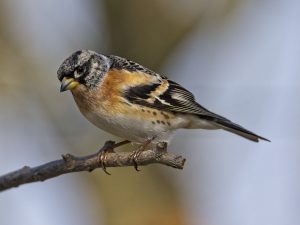
This beautiful finch feeds mainly on seeds and plant remains, although in summer it can also capture invertebrates. The population of Extremadura is very fluctuating as some winters large flocks appear and others are barely seen. It breeds in the boreal forests of northern Europe and appears in Extremadura only during the winter. We can observe it in all kinds of habitats (Mediterranean mountain included), as the flocks usually move around in search of food in different ecosystems.
Bullfinch Pyrrhula pyrrhula
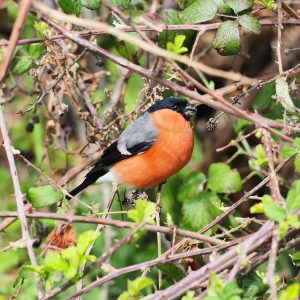
One of the wintering woodland birds in Extremadura, it is one of the most colourful finches and can be distinguished from a distance by its orange-red belly. Its preferred habitat is the deciduous, coniferous and riparian forests. We also find it in the mosaics of fields, hedges, fruit plantations, orchards etc. Some interesting points to observe are Cornalvo reservoir, Villuercas mountain range, San Pedro, Gata, Monfragüe and the Tajo International area.
Cetti’s warbler Cettia cetti
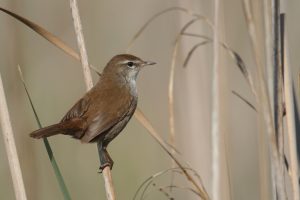
This species of nightingale has more discreet colours than its relative the common nightingale. It is also notable for its powerful song and lives in woods and hedges and reeds. Cetti’s warbler feeds on small insects, but in autumn it can eat small berries and fruit, like the common nightingale. It is sedentary although it can make small micro-migrations in winter looking for warmer areas. The Cetti’s warbler is distributed throughout the region, being quite common.
Cirl bunting Emberiza cirlus
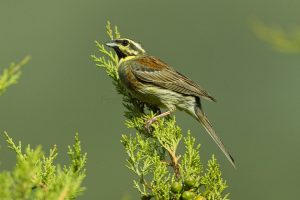
A little bigger than a sparrow, it is characterized by a yellowish belly and a yellow head with black stripes, in the case of the female with duller tones. It has a predilection for lush and humid forests, always with meadows and grasslands nearby, in which it feeds mainly on seeds. However, in the breeding season it feeds its chicks with insects, being sedentary in the region. In winter its population also increases with specimens from the north and is relatively abundant in the community.
Coal tit Periparus ater
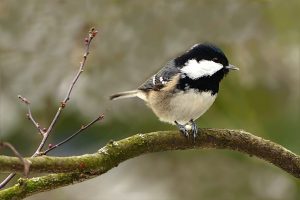
Not as common as its companion the Great tit, but quite frequent in coniferous and mixed forests, parks and gardens. In Extremadura we can observe it mainly in the forests of the northern half of Cáceres, being very rare in Badajoz. Slightly smaller and with duller colors than the Great tit, it is easy to differentiate. Sedentary, its populations are stable, although in the winter months it increases with partial migrations of specimens from the north of the peninsula. It feeds mainly on invertebrates and seeds.
Common chaffinch Fringilla coelebs

The size of a sparrow, it is characterized by its blue hood and orange ochre chest. Females have duller plumage and tend to nest in all types of forests. It is one of the most common woodland birds in Extremadura due to its great capacity to adapt, and can also be found in urban parks and gardens. The common chaffinch feeds on insects as well as small fruits, buds and seeds. It is present throughout the year in practically all the forest masses of the region.
Common chiffchaff Philloscopus collybita

Another small and restless bird breeds in mountain and riverine forests in the north of Cáceres. During the winter it spreads throughout the region, and its population is clearly increased with specimens from northern Europe. It feeds mainly on small invertebrates, although it supplements its diet with small fruits and pollen in spring. At present it is not dawn, although its population is not particularly abundant either.
Common cuckoo Cuculus canorus
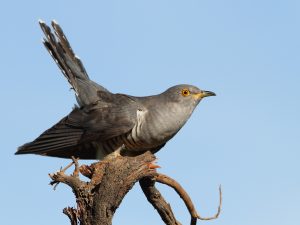
Migratory bird that visits us in summer and whose main peculiarity is that it lays its eggs in the nests of other species of birds, sometimes even of little birds several times smaller than them. It feeds on insects, thus parasitizing insectivorous birds’ nests, and the chicks usually expel the parasitized bird’s young from the nest, as they grow faster. The cuckoo makes an unmistakable song and stylised silhouette, reminiscent of a sparrowhawk, allow us to identify it easily. This bird lives in forest areas where it does important ecological work by feeding on caterpillars and other insects considered to be pests. It is distributed throughout the region but the San Pedro mountain range and the north of the province of Cáceres are home to particularly interesting densities.
Common firecrest Regulus ignicapilla
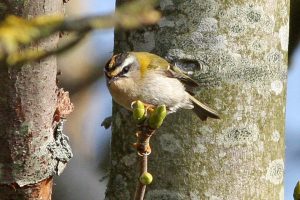
This small passerine is characterized by its diminutive size, being one of the smallest birds in Europe. Present in Extremadura mainly in winter, in the north of the province of Cáceres we can find some breeding populations. Of marked forest character, it likes cold and humid forests that are at a certain altitude. However, in winter specimens come from colder areas, both from the Peninsula and other European countries, and we can find them at lower altitudes. Its diet is exclusively insectivorous.
Common nightingale Luscinia megarhynchos
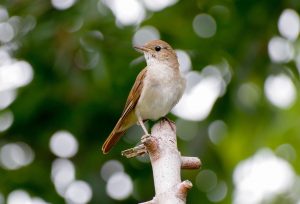
The size of a sparrow, its back and wings are brown while its belly is clear. It is characterized by its beautiful and powerful song, which quickly denotes its presence but is difficult to observe. The nightingale lives in areas of thick vegetation, feeding on insects, small berries and fruits. It reproduces in the region but in winter it migrates to Africa. The common nightingale especially likes very thick woods on the banks and in cool areas.
Common redstart Phoenicurus phoenicurus
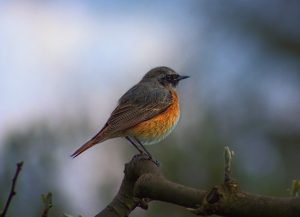
Slightly smaller than a sparrow, it has beautiful plumage with a grey back, black throat and orange breast. Very slender and with electric movements, it is present in Extremadura during the breeding season when it feeds on insects. It lives in mature hardwood and coniferous forests, generally in interior mountain ranges. We can observe it in Lasa Dehesas de Jerez and in the forests of the central mountain ranges of Badajoz, although it is not especially frequent.
Eurasian blackcap Sylvia atricapilla
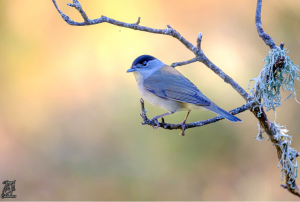
Similar in size to a sparrow, it stands out as its own name suggests because of its black cap, black in males and brown in females. Typical of leafy forests, wooded banks, fruit trees and gardens, where it feeds on small invertebrates. However, it can also feed on fruits when they are within its reach. Breeding in Extremadura, its population increases in winter with the arrival of specimens from more northern areas. Abundant and present throughout the region.
Eurasian blue tit Cyanistes caeruleus
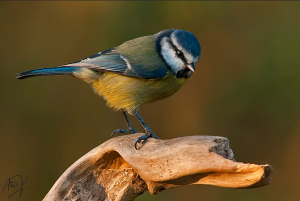
Along with the great tit, it is one of the most typical woodland birds in Extremadura. Its presence is quickly noted due to its colourfulness, its songs and its tireless activity. Frequent in many types of forests: woodlands, pine forests, riverside woodlands or gardens, where it feeds on small invertebrates. It is also a great ally of organic farming being an effective pest control and is present throughout the year throughout the region.
Eurasian jay Garrulus glandarius
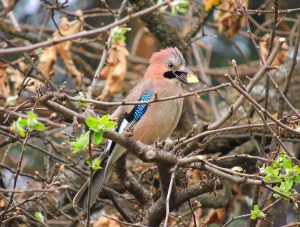
This beautiful corvid is one of the most intelligent woodland birds of Extremadura. It is a total opportunist and is capable of imitating a wide variety of sounds as needed. It adapts to both closed forests and more dispersed woodland areas such as wood pastures. We can frequently observe him in Tiros and Villuercas mountains, the environment of the Cornalvo and Canchales reservoirs, Los Llanos de Cáceres, Magasca and Trujillo, La Vera region or Jerte and Ambroz valleys.
Eurasian nuthatch Sitta europaea

Slightly larger than a sparrow, it is easily identified by its bluish back. It usually climbs up and down the trunks, both up and down, feeding on the invertebrates present in them. Present in all types of mature forests, the best areas to observe it are the pastures near Canchales and Cornalvo, Llanos de Cáceres, Magasca and Trujillo, Sierra de San Pedro, La Vera, valleys of Jerte and Ambroz and the area of Granadilla.
Eurasian siskin Aegithalos caudatus
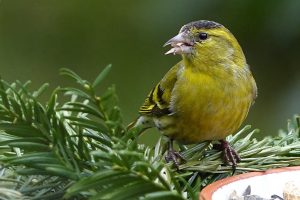
Although there is a resident population on the Iberian Peninsula throughout the year in some mountain ranges in the northern half, it is in autumn and winter that it can be seen in Extremadura. It can be seen mainly in forest areas (often riverside woodland), but also in the countryside and on the edges of cultivated areas. At this time of year, its diet is mainly vegetable: seeds and some plants. Its colouring, although it may seem similar to the greenfinch or greenfinch, is very characteristic, with yellow patches on wings and tail.
Eurasian woodcock Scolopax rusticola
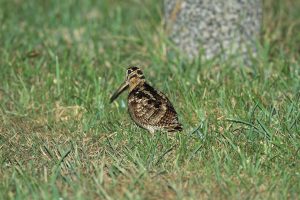
Also known as Woodcock and the size of a pigeon, it is one of the most secretive woodland birds in Extremadura. It comes to Spain in winter, returning to Northern Europe in spring to breed. Its habitat is the forest floor, generally lush, in which it feeds on worms and small invertebrates. The woodcock lives in a wide variety of forests: holm oak, cork oak, oak… as long as they are sufficiently humid. It is very difficult to observe because when it detects danger, it is crushed motionless on the ground and its plumage is confused with it.
Eurasian wren Troglodytes troglodytes
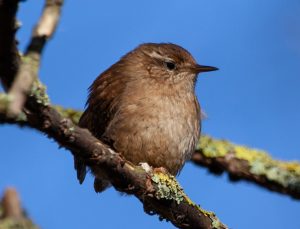
It is one of the smallest forest birds, brown in colour and very restless. Its typical posture is with its tail raised, forming a 90 degree angle with the ground and is very complicated to observe. However, its song is very characteristic and powerful for its size. The eurasian wren lives in the thick woods and leafy hedges of the whole region, feeding on small insects. It builds a very curious nest, spherical in shape and formed by herbs and mosses, and currently has no major conservation problems.
Eurasian wryneck Jynx torquilla
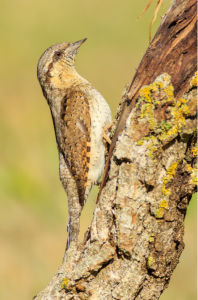
The size of a thrush and with a really mimetic plumage, it appears in thickets, banks, dense pastures and other wooded areas although it is very difficult to detect. It is present in the region throughout the year, although a percentage continues to migrate to Africa to spend the winter. When it feels threatened it moves its head from side to side in a similar way to a snake to scare off possible predators. The best way to locate it is by its characteristic song, but it is one of the most difficult forest birds to see, and it is present in both provinces.
European crested tit Lophophanes cristatus
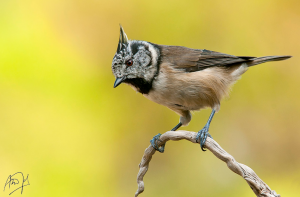
A small bird present in Extremadura all year round, it differs from the common tits in its characteristic feathery crest. It lives mainly in pine forests, but also in holm oak and cork oak groves with underbrush, where it feeds on small insects and caterpillars. It has a fundamental ecological role, ridding us of many forest pests. Its distribution is dispersed throughout the region, as it requires mature forests with “old” trees in whose hollows it nests.
European green woodpecker Picus viridis

It is the largest of the woodpeckers present in the region, also relatively abundant. It frequents riverside woods, forests or closed pastures of holm oak, cork oak, oak… Whenever the trees are dense, it denotes its presence by its strident song, similar to the whinnying of a horse. Sierra de las Villuercas is an excellent place to observe it. Also we can locate it in Hornachos area, surroundings of Don Benito and other forests of the region.
Garden warbler Sylvia borin
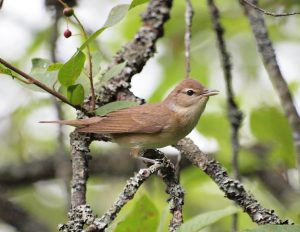
This warbler, with its inconspicuous plumage, likes more or less dense wooded areas. More compact and robust than other warblers and brownish in colour, it is more easily identified by its song than by direct observation. Not very frequent in Extremadura, it is more easily observed during migratory passes than in the summer months, when some populations settle in the northern half of the Iberian Peninsula to breed. It is usually found in rather cool and humid forests and in winter it migrates to Africa, to the south of the Sahara desert.
Goldcrest Regulus regulus

Of a very similar size to the common firecrest, it is scarcer in the region. There is a very small breeding population in the north of the province of Cáceres, in some parts of the Central System. The goldcrest differs from its relative by lacking the clear superciliary list and also lacking the black eye list. It has a predilection for coniferous forests, although it can also be found in deciduous forests, especially during the winter. Its diet is also insectivorous and it often shares habitat with its relative.
Golden oriole Oriolus oriolus
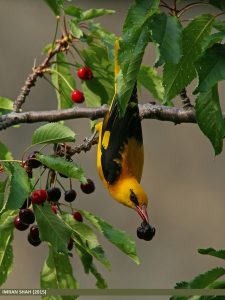
Paseriform of very striking colours, it quickly denotes its presence in the forests of Extremadura with its strident singing. We can observe it from March, when it returns from its winter quarters in Africa, in all kinds of forests with a certain amount of humidity: oak groves, ash groves, riverside forests… It feeds on both small invertebrates and fruits, being very common near cherry, fig, blackberry and grape plantations… The Guadiana dam, Villuercas mountain range, La Vera, Jerte valley, Ambroz valley and the area of Granadilla are good spots to observe it.
Great spotted cuckoo Clamator glandarius
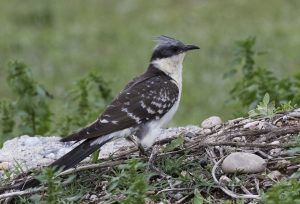
The size of a cuckoo and similar breeding habits (it lays its eggs in the nests of other species), it is one of the woodland birds of Extremadura with the greatest ecological value as it usually uses the nests of magpies, helping to regulate their populations. It visits Extremadura in spring, when we can witness the spectacle produced by the magpies chasing them when they try to lay their eggs in their nests. This species is threatened worldwide due to the loss of its habitat. It does not present great threats in Extremadura due to the abundance of the species it parasitizes. Frequent in Dehesas de Jerez, Los Llanos de Cáceres, Magasca and Trujillo and the surrounding dehesas of Almaraz lake.
Great spotted woodpecker Dendrocopos major
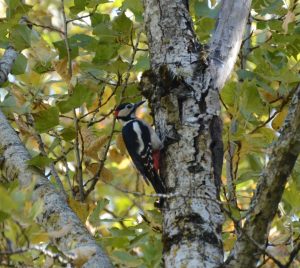
It is the most abundant of the “woodpeckers” and its presence is easily revealed by the characteristic sound it produces when it pierces the tree trunks with its beak, as if it were a hammer drill. Riverside woods, pine forests and other dense forest masses are its favourite habitats. They are especially abundant in Tiros and Villuercas mountain ranges and in the woodlands near the Cornalvo and Canchales reservoirs.
Great tit Parus major

Slightly smaller than a sparrow and more stylish, it is one of the most typical woodland birds of Extremadura. Although its plumage is very colourful, it is quite discreet when in the middle of leafy trees. It feeds on small invertebrates and has a great variety of different songs. The great tit lives in all kinds of forests, including urban parks and gardens, as it tolerates human presence very well. It is now quite abundant throughout the region.
Greenfinch Chloris chloris

Another bird the size of a sparrow, with bright green plumage with yellow spots. It is characterized by a robust beak with which it is able to break very hard seeds. It is abundant throughout the region in forests, woodlands and urban gardens. The population is sedentary and feeds on seeds and fruit, although in the breeding season it fattens its chicks with invertebrates. As it does not have excessive habitat requirements, it is one of the most abundant birds in these ecosystems.
Hawfinch Coccothraustes coccothraustes

Medium sized bird, it stands out because of its robust beak, as its name indicates. It lives in wooded areas with underbrush, where it feeds on seeds and hard nuts that it breaks with its beak. It is present all year round in the community, widely spread throughout it, but it is not abundant. In addition to the typical forests: oak, holm oak, cork oak… It can also live in forests of ash, elm or wild olive trees, even in parks with trees that produce fruit and seeds.
Iberian chiffchaff Philloscopus ibéricus
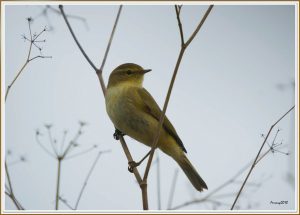
Recently listed as a new species, it is virtually identical to the common chiffchaff. The easiest way to tell them apart is by their song and because the Iberian chiffchaff is only a summer inhabitant of the peninsula. In Extremadura it is not particularly abundant, being found on the border between Cáceres and Salamanca and on the southern border between Badajoz and Andalusia. It is mainly found in mountain forests, where it feeds mainly on insects.
Lesser spotted woodpecker Dendrocopos minor
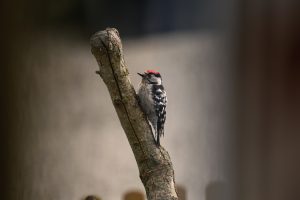
It is the smallest of the woodpeckers in the region, slightly larger than a sparrow. Its plumage is similar to that of its relative and its beak is more abundant, although in its case the beret is red. Present throughout the year in the region, it feeds on insects that it captures in the bark of trees. It has a predilection for riverside woods, oak groves and cork oak forests. In Extremadura we can observe it in Villuercas, Sierra de San Pedro, cork oak groves of the southwest of Badajoz and in the forests of the north of Cáceres.
Long-tailed tit Aegithalos caudatus
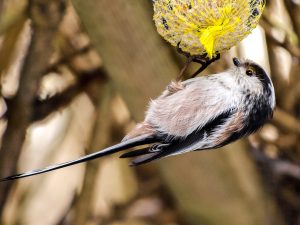
Small bird characterized by a tiny beak and very long tail. It moves in groups of 8 to 14 individuals in forests with abundant undergrowth and banks. Present all year round in Extremadura, it feeds mainly on small insects, but also on seeds. They build a very elaborate nest whose interior is covered with mammalian feathers and hairs and whose exterior is camouflaged with mosses and lichens. It is not particularly abundant but neither does it have great conservation problems, being distributed throughout the region.
Melodious warbler Hippolais poliglotta

Small, greenish-yellow passerine. It is present throughout the region, with a greater abundance in riverside forests and the edges of all types of woodland with scrub. This bird can be seen all year round, except in winter, when it migrates to West Africa, south of the Sahara. It feeds mainly on insects, and may consume fruit in the weeks prior to migration. It is quite abundant and its populations are currently showing a positive trend.
Red crossbill Loxia curvirrostra

Typical bird of coniferous forests, rather scarce in the region. It can be found mainly in the pine forests of the north of the province of Cáceres. The crossbill is easily identifiable by its characteristic beak. It feeds mainly on pine nuts and other nuts, complementing its diet with insects and other invertebrates. Sedentary in nature, it can be seen all year round in Extremadura, although it sometimes migrates to Spain from northern European countries. Despite being a scarce bird in the region, its population is not currently threatened.
Short-toed treecreeper Certhia brachydactyla

Very small bird, with a very fine, curved beak that it uses to capture small insects, mites and worms that live under the bark of trees. Its plumage is very cryptic and it is difficult to observe if we do not look very carefully. Theese woodland birds of Extremadura lives all year round in different types of forests, both perennial and deciduous, and even in urban parks. Its population is stable and relatively abundant.
Spotted flycatcher Muscicapa striata

Although it can occupy a wide variety of habitats, it has a predilection for wooded areas with undergrowth, scrubland and nearby wetlands. A summer visitor to the Iberian Peninsula, it can be found practically all over Extremadura. It feeds mainly on insects, but can sometimes eat berries and fruit, especially in autumn. This species is not currently endangered and its populations are stable.
Tree pipit Anthus trivialis
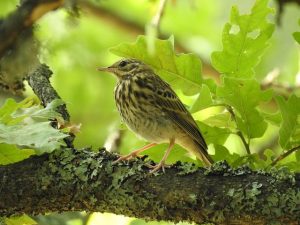
A rare bird in the region, where it can be seen mainly in winter. It breeds mainly in northern Europe and Asia and hibernates mostly in southern Africa and India. However, during its migration it can be seen throughout the region. The tree pipit inhabits forest edges, open forests and thickets with some woodland. It is very similar to the Meadow Pipit, differing in that it has a more pronounced eyebrow and a thicker and pinker bill.
Western bonelli’s warbler Philloscopus bonelli
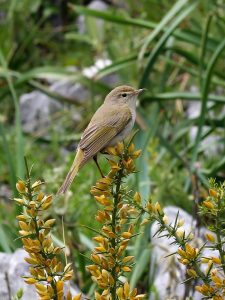
Not very common in Extremadura, it is a relatively frequent bird in the northern half of the peninsula that has gradually colonised the north of Extremadura, mainly the north of the province of Cáceres. It can also be seen in the east of this province, in the Villuercas area. Very forest-dwelling, it adapts to a wide variety of forests of different species: oak, pine, holm oak, cork oak… Very similar to another Philloscopus, it can be identified mainly by its song and, as a characteristic feature, it has a yellowish obisk.
Willow warbler Philloscopus trochilus

Although it has not been proven with certainty that it breeds on the Iberian Peninsula, there are numerous sightings during the migratory period. It breeds in central and northern Europe and migrates to Africa in winter, so it can be seen on both migratory routes. This warbler likes forests of different species, with plenty of undergrowth and shrubs. It is more common in the province of Cáceres and differs from the common and Iberian in that it tends to be more yellowish, with lighter legs and the pale eyebrow is very marked.
Thanks to Álvaro de las Heras, Ángel Cañones, Fernando Mostacero and Mariano Cordero.





